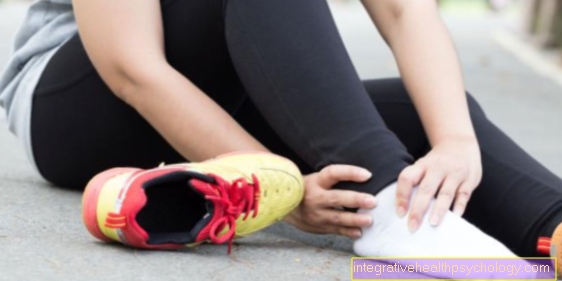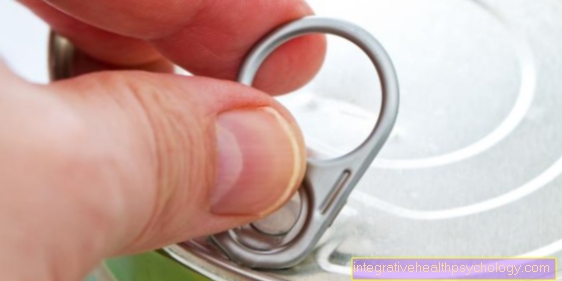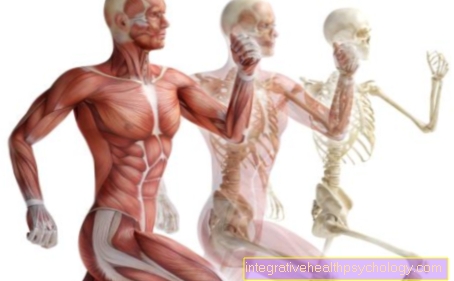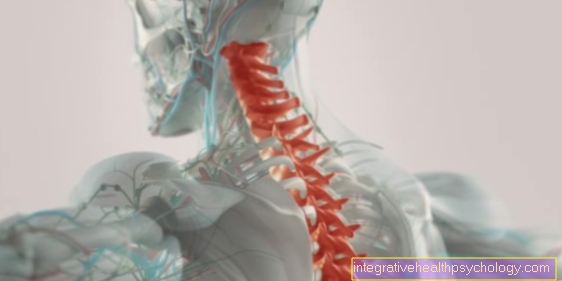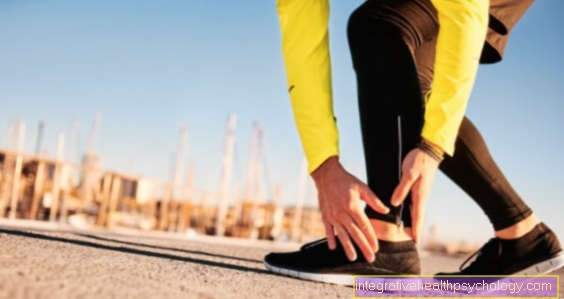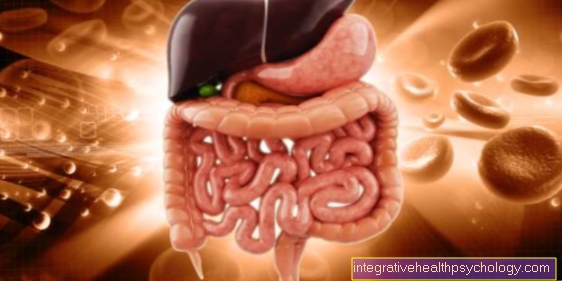Muscle inflammation
definition
Muscle inflammation, also known as "myositis", is an inflammatory process that takes place in the muscle. Such myositis can have a wide range of causes. Bacterial or viral pathogens do not always have to trigger the inflammation, but degenerative diseases or autoimmune reactions can also be behind it.
A distinction is made between three types of muscle inflammation: the so-called "polymyositis", "dermatomyositis" and "inclusion body myositis", whereby polymyositis and dermatomyositis are very similar. The most commonly affected group is adults over 50, but children are also affected.
Depending on the cause, the muscle inflammation must be treated differently. Inflammation caused by pathogens can often be eliminated well, systemic or degenerative causes often require lengthy treatment. Accordingly, the forecasts are also very different.
The clinical picture of affected patients can include a lot from a symptom-free course to muscle paralysis.

causes
The causes of muscle inflammation are numerous. Muscle inflammation is one rather rare disease and when it occurs, affects it mainly children or older People. Identifying the type of myositis that is present often helps identify the cause.
Muscle inflammation is only very rarely caused by pathogens. This includes above all bacteria, Viruses or Parasites. In our regions they are of no clinical relevance. Myositis is often an accompanying symptom of systemic inflammatory reactions in the body. These include above all rheumatic inflammation.
Are not uncommon Autoimmune reactions the cause of muscle inflammation. Detects this in autoimmune reactions immune system mistakenly the body's own structures as foreign and tries to eliminate them. In myositis, the reaction is directed against small blood vessels in the muscle. As a result, the blood circulation deteriorates and the muscle may atrophy.
The polymyositis takes place in most cases no clear cause. This is called "idiopathic“.
Especially with dermatomyositis there is a risk of a Tumor disease the cause is. If dermatomyositis is newly diagnosed, a tumor must therefore always be considered, above all Ovarian cancer are common in this context.
Symptoms
Common symptoms of muscle inflammation are Muscle weakness, but also local pain and Muscle aches. A inflammation is defined, among other things, by 5 main symptoms. These include pain, overheating, redness, swelling and functional impairment. These symptoms can also often be observed with muscle inflammation.
The location of the pain depends on the location of the inflammation. Any muscle can potentially be affected, from the neck to the leg. Many patients also give the feeling of one Sore muscles on. It can also difficulties swallowing come.
Since some of the vessels also have musculature, the blood vessels may be involved, a "Vasculitis". A symptom of this is the "Raynaud's Syndrome“, In which there is lightening and darkening of the skin color, especially on the fingers, caused by cramping of the blood vessels supplying it.
The extension of the polymyositis is the dermatomyositis. With it, the inflammation spreads into the skin and in addition to the symptoms of muscle inflammation, there is reddening and swelling of individual skin areas.
diagnosis
For the diagnosis of muscle inflammation, the most important ones are clinical symptoms decisive. Typical first signs are Muscle weakness and local Pain at the site of inflammation. However, symptoms develop very slowly in most cases. There are other examination methods in the clinic that allow a more precise diagnosis.
Especially Blood tests allow conclusions to be drawn about muscle inflammation. Inflammation parameters in the blood indicate acute inflammation. The most important here are CRP, Leukocytes and sedimentation rate. If they are increased or changed, this indicates an inflammation in the body. Other values point to the muscle as the origin, including so-called "LDH, transaminases, creatine kinase and myoglobin". These molecules are mainly found in muscles and indicate the destruction of muscle cells if they are found in increased numbers in the blood.
For a reliable diagnosis if a muscle inflammation is suspected, this counts biopsy. A small needle is inserted into the affected muscle in order to remove tissue and examine it closely. If a tissue sample is reached from the right place, which is not always possible, the exact diagnosis can often be made and the type of myositis determined.
therapy
If you feel persistent muscle weakness and severe pain, you should consult a doctor. Since muscle inflammation is a rather rare disease in our regions, it is not always easy to make a clear diagnosis.
However, if there is a suspicion of inflammation and if it is, for example by a Tissue sample confirmed, must therapy started immediately to stop the inflammatory process. Otherwise, chronic, painful inflammation can occur, which in the long term leads to a strong reduction in muscle mass.
A immediate protection is important for the affected muscle region. The doctor becomes medication cortisone- Prescribe preparations. This take effect after a few days to weeks, in some patients it may take up to 6 weeks for improvement. The therapy is controlled with constant blood testsuntil the inflammation levels and muscle-specific enzymes in the blood return to normal.
In severe cases for which even cortisone preparations cannot help Immunosuppressants be taken. They lower the immune system and thus also reduce the body's own inflammatory reaction. However, this makes the body more sensitive to all possible pathogens.
With certain muscle groups, there is also one during the acute phase of inflammation physiotherapy on. Especially when the Swallowing or breathing muscles this is important so that these do not lose too much of their function.
General rehabilitation is only possible when the inflammation has healed or is no longer in an acute phase. Gentle too long goes with one loss of still existing Muscle functions a. The aim of rehab is to maintain as many functions as possible and, after the inflammation has subsided, to rebuild muscle functions as well as possible.
Inflammation of the muscles in the arm
There is an inflammation of the muscles in the area of the arm and especially of the entire upper arm not infrequently. It is often triggered by rheumatic inflammation. One symptom of myositis in the arm is this Muscle weakness. Especially with muscles close to the trunk, weakness and slackening quickly develop.
The affected patients often notice the inflammation of the muscles in the arm when they occur Sore muscles feeling without cause to have. The sore muscles cannot be attributed to previous sporting activity. It quickly leads to the patient being unable to raise their arms above a certain level.
After a precise diagnosis has been made, therapy must be initiated immediately before degenerative changes in the muscle occur. Above all, restraint and drug therapies must first be observed. After healing, a physical therapy become necessary.
Inflammation of the muscles in the calf
The calf muscles can also be affected by muscle inflammation. Muscle parts that are close to the torso are quickly affected. Thighs and calves are therefore often affected.
With initial myositis, one develops over a long period of time Muscle weaknessmade by a local pain can be accompanied. The feeling of sore muscles can also occur without the Leg muscles was actively used. If there is also swelling and redness in the calf, inflammation is likely.
The main problem for the patient is muscle weakness in everyday life. Simple everyday tasks such as climbing stairs become a pain in the face of severe muscle inflammation. Often the inflammation spreads symmetrically from the trunk. Only the legs are rarely affected.
A rare phenomenon in muscle inflammation can be observed in the calf area. Protracted inflammatory processes lead to a "Pseudohypertrophy“The calf muscles. The calf thickens as if a lot of muscle mass had built up in a short time. However, the body effectively breaks down and replaces muscle with muscle connective tissue and Adipose tissue. The calf becomes larger, but the muscle strength decreases.
Inflammation of the muscles of the shoulder
Especially those shoulder is a frequently affected muscle area in inflammatory changes. It borders directly on the trunk muscles from which many inflammations originate.
In most cases, both shoulders are affected symmetrically. The Shoulder muscles plays a role not only in shoulder-to-torso movements, but also in rotating and lifting the arm. Affected patients often complain Muscle weakness With pain trying to raise your arms. Long-term inflammation can also affect the shoulder muscles Loss of muscle masse, which is mainly replaced by adipose tissue.
Together with the Arm muscles often needs the shoulder area after an inflammation physiotherapy to regenerate muscle strength.
Inflammation of the muscles in the chest
If there is inflammation of the muscles in the chest, it can often be small hardened nodules Keys. These are foci of inflammation. The inflammation in the Chest muscles mostly occurs symmetrically and can be acute or chronic. Especially when they're through Pathogen is caused, it often has an acute, painful but completely subsiding course. Many bacterial or viral pathogens are possible. Inflammation from parasites is extremely rare.
The inflammation arises in the chest mostly without a cause, so idiopathic.
In the case of long, chronic courses, so-called "atrophies" of the muscle also occur, ie a reduction in muscle mass. The chest muscles are attached to the upper arm and are mainly responsible for the rotation of the arm. This occurs when there is inflammation Feelings of weakness, more burning aching or in the case of acute inflammation, especially stabbing Pain on.
Inflammation of the muscles in the neck muscles

In many cases, muscle inflammation spreads from the trunk to the Neck muscles out. The myositis in the neck is particularly uncomfortable in everyday life. The neck muscles allow any movement of the head, both rotations and easy holding up.
Strength Muscle aches and Feelings of weakness lead to the fact that the patient can move the head very restricted. Everyday things such as driving a car become almost impossible.
Also localized in the throat Throat and pharynx muscles. With severe muscle inflammation, these muscle groups are restricted. difficulties swallowing are a common consequence. Every movement is painful and agonizing for the patient. Immediate rest, if this is possible in the throat area, and medication treatment by the doctor will be necessary.
In serious cases, the inflammation can spread to the Respiratory muscles spread, which can sometimes be life-threatening. High dose Cortisone therapies must then be set by the supervising doctor.
Inflammation of the muscles in the elbow
One form of muscle inflammation is the so-called "Myositis ossificans“. In the course of accidents, injuries occur, as a result of which tissue ossifies in wrong places. On the one hand, this can be hereditary and progressive Ossification of connective tissue, or as a result of injuries or operations.
Especially in the Elbow joint ossifying muscle inflammation is a rare side effect of injuries, including operations.
The ossification can possibly spread to the upper arm muscles. Immediate therapy, sometimes surgery, must be started immediately to stop the process. Permanent damage and impairment of joint function is a possible consequence. The joint then becomes more and more rigid and immobile due to the increasing bony structures.
Myositis is often noticeable when severe pain still occurs after a few days to weeks after an injury and treatment. Unfortunately, the ossification can only be determined in radiological images after it has long been active.
Inflammation of the muscles in the shin
Similar to the calf muscles, myositis can also develop in the muscles around the Shin unfold around. Movement restrictions, muscle weakness and pain are the result. Direct pain in the shin is rather rare. The pain is only felt when local pressure is applied to the affected area or when the Lower leg muscles. Rest is then indicated.
therapy
If you feel persistent muscle weakness and severe pain, you should consult a doctor. Since muscle inflammation is a rather rare disease in our regions, it is not always easy to make a clear diagnosis.
However, if there is a suspicion of inflammation and if it is, for example by a Tissue sample confirmed, must therapy started immediately to stop the inflammatory process. Otherwise, chronic, painful inflammation can occur, which in the long term leads to a strong reduction in muscle mass.
A immediate protection is important for the affected muscle region. The doctor becomes medication cortisone- Prescribe preparations. This take effect after a few days to weeks, in some patients it may take up to 6 weeks for improvement. The therapy is controlled with constant blood testsuntil the inflammation levels and muscle-specific enzymes in the blood return to normal.
In severe cases for which even cortisone preparations cannot help Immunosuppressants be taken. They lower the immune system and thus also reduce the body's own inflammatory reaction. However, this makes the body more sensitive to all possible pathogens.
With certain muscle groups, there is also one during the acute phase of inflammation physiotherapy on. Especially when the Swallowing or breathing muscles this is important so that these do not lose too much of their function.
General rehabilitation is only possible when the inflammation has healed or is no longer in an acute phase. Gentle too long goes with one loss of still existing Muscle functions a. The aim of rehab is to maintain as many functions as possible and, after the inflammation has subsided, to rebuild muscle functions as well as possible.






